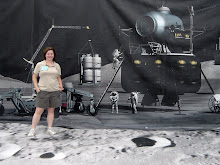I've already explained that Mossbauer spectroscopy determines the kinds of iron-bearing minerals in the rock. The APXS is the Alpha Particle X-Ray Spectrometer. It works by exposing the rock target to a source of alpha particles and X-rays and then measuring the alpha particles and X-rays that come back. Each element interacts with X-rays differently, the X-ray interaction depends on the electron shells of an atom. When an atom is hit with an X-ray, the atom can absorb the energy by having one of its electrons go to an excited state. The excited state is unstable, so the electron will want to come back down and when it does, the atom emits energy. The exact frequency of the emitted energy is specific to the flavor of the atom - that is, the exact element. Therefore, you can look at a specific frequency and count the number of returned X-rays and know how much of that element is in the target. In practice, the MER APXS looks at a whole spectrum of frequencies returned and we pick out the peaks at specific energies to say how much of each element is in the rock. Unlike Mossbauer, which is tuned to iron, APXS detects the amount of every element in the rock. But APXS doesn't tell us anything about how those elements are combined into minerals. So, we like to use the APXS and Mossbauer on the same rock to get both the elemental makeup and the mineralogy.
 APXS and Mossbauer spectra aren't much to look at unless you're a geek who likes squiggles on graphs (ok, I admit I like them). But this week we also found a nice flat rock exposure that we could brush with the RAT. The Rock Abrasion Tool grinding bit on Spirit wore out long ago, but it still has fantastic wire bristles that can brush soil away. Check out these before and after hazcam shots of the rock, the RAT brush, and placing the APXS on the brushed spot. The RAT brush spot is the spectacular shining beacon in the middle left. (I made this using gifninja.com.)
APXS and Mossbauer spectra aren't much to look at unless you're a geek who likes squiggles on graphs (ok, I admit I like them). But this week we also found a nice flat rock exposure that we could brush with the RAT. The Rock Abrasion Tool grinding bit on Spirit wore out long ago, but it still has fantastic wire bristles that can brush soil away. Check out these before and after hazcam shots of the rock, the RAT brush, and placing the APXS on the brushed spot. The RAT brush spot is the spectacular shining beacon in the middle left. (I made this using gifninja.com.)Then we looked at the shining beacon of brushed rock close-up. I mean REALLY close up. Here's the Microscopic Imager mosaic of the brushed spot, which is about 3cm across. Though it's a mostly flat-ish rock, it's got a knobby texture that we're still discussing. Compare this texture with what we saw at Madeleine_English, described below.


